Alcohol Abuse and Violence in Indigenous Communities: An Essay
VerifiedAdded on 2023/01/09
|9
|2513
|99
Essay
AI Summary
This essay delves into the critical issue of alcohol abuse and its associated violence within Aboriginal and Torres Strait Islander communities in Australia. It highlights the significant health disparities faced by this population, linking them to factors such as historical colonization, socioeconomic disadvantage, and racism. The report emphasizes the prevalence of high-risk drinking and its detrimental effects, including physical harm, injuries, and chronic diseases. It examines the role of social determinants like poverty and lack of access to healthcare, which contribute to increased alcohol consumption and violence. The essay also discusses the impact of alcohol on Aboriginal women and the historical context of alcohol introduction. It concludes by emphasizing the need for improved healthcare access, awareness programs, and government action to address these complex issues and reduce health inequalities, advocating for a human rights-based approach and a focus on primary healthcare interventions. The reflection section provides insights into the learning experience and future professional goals related to addressing these disparities.
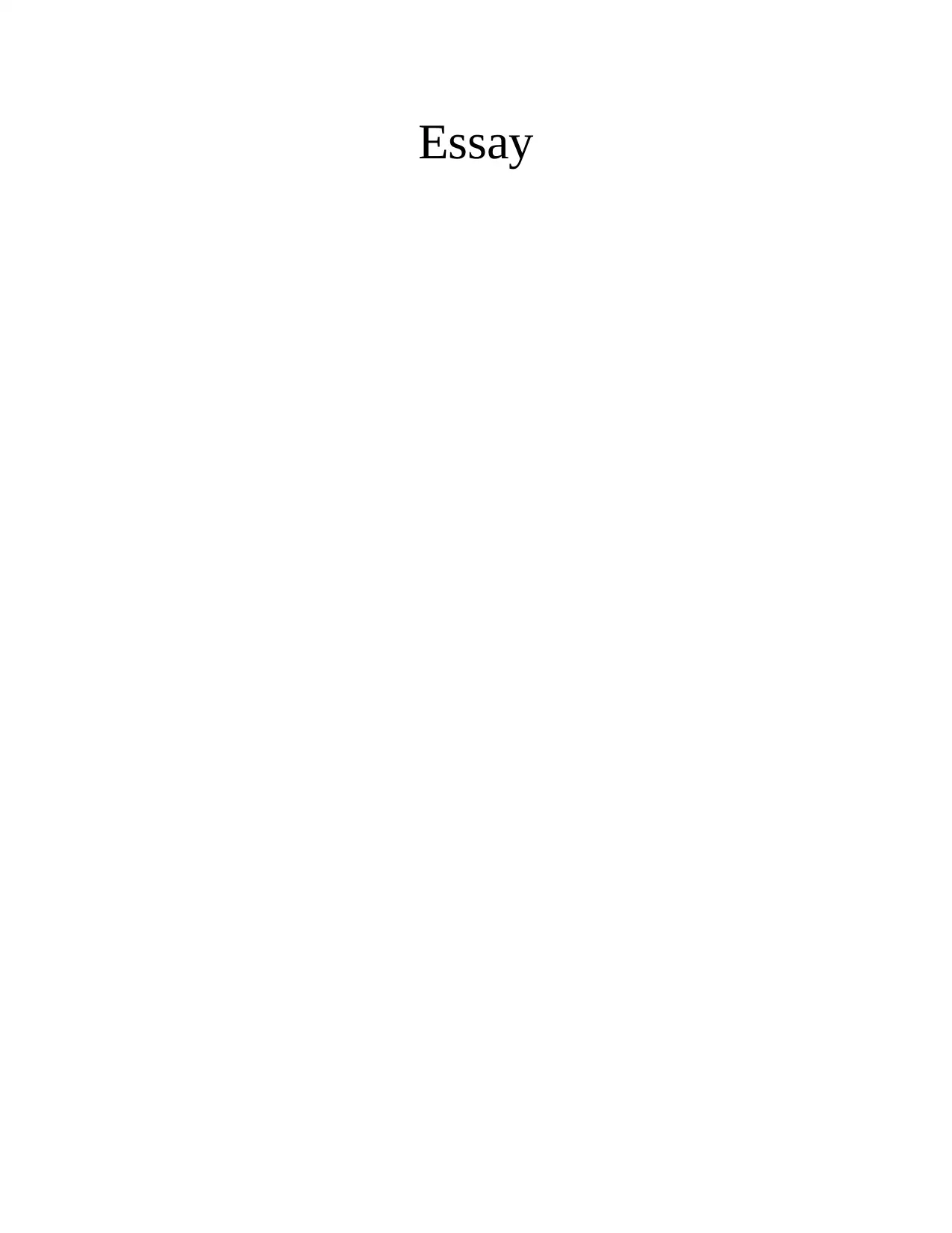
Essay
Paraphrase This Document
Need a fresh take? Get an instant paraphrase of this document with our AI Paraphraser
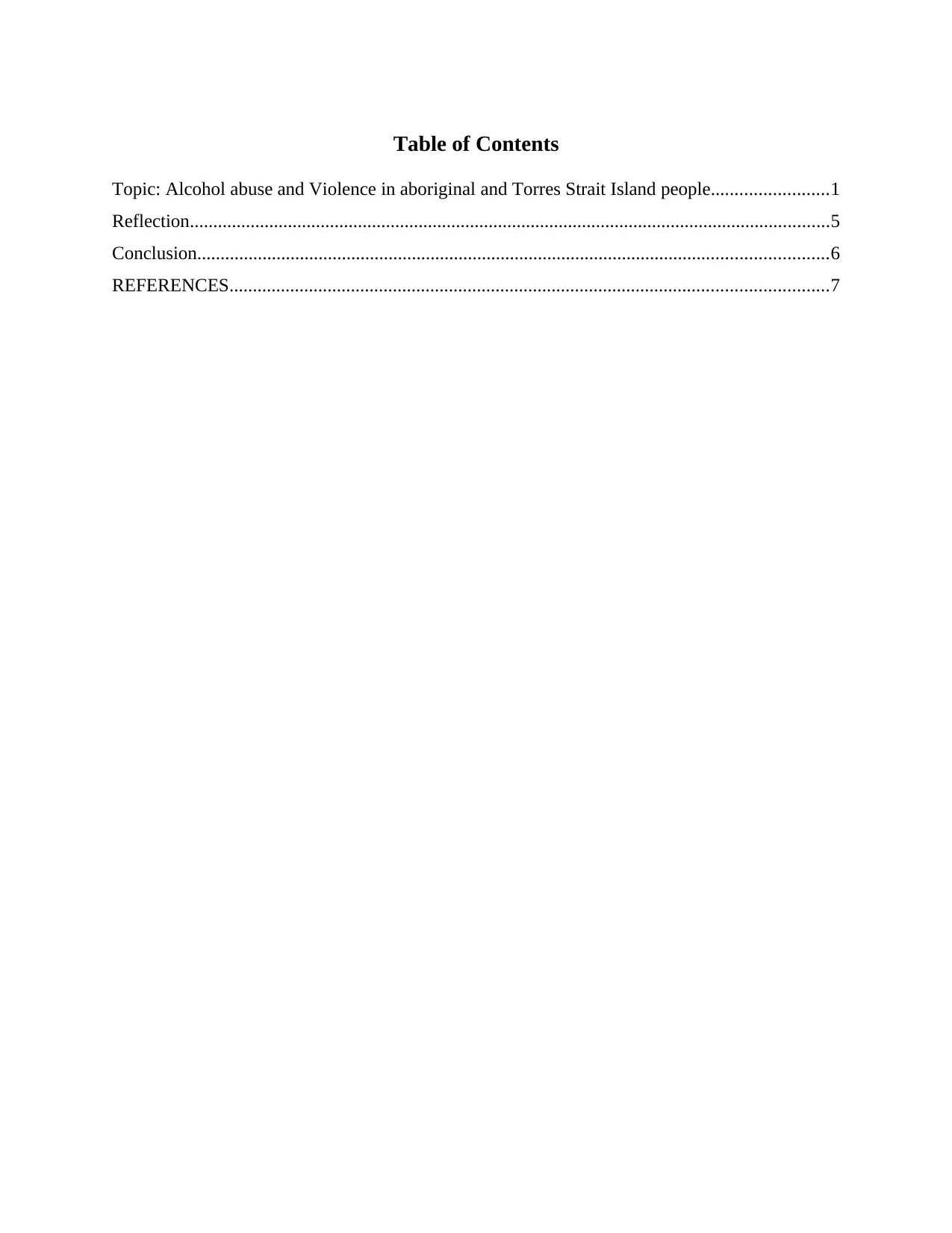
Table of Contents
Topic: Alcohol abuse and Violence in aboriginal and Torres Strait Island people.........................1
Reflection.........................................................................................................................................5
Conclusion.......................................................................................................................................6
REFERENCES................................................................................................................................7
Topic: Alcohol abuse and Violence in aboriginal and Torres Strait Island people.........................1
Reflection.........................................................................................................................................5
Conclusion.......................................................................................................................................6
REFERENCES................................................................................................................................7
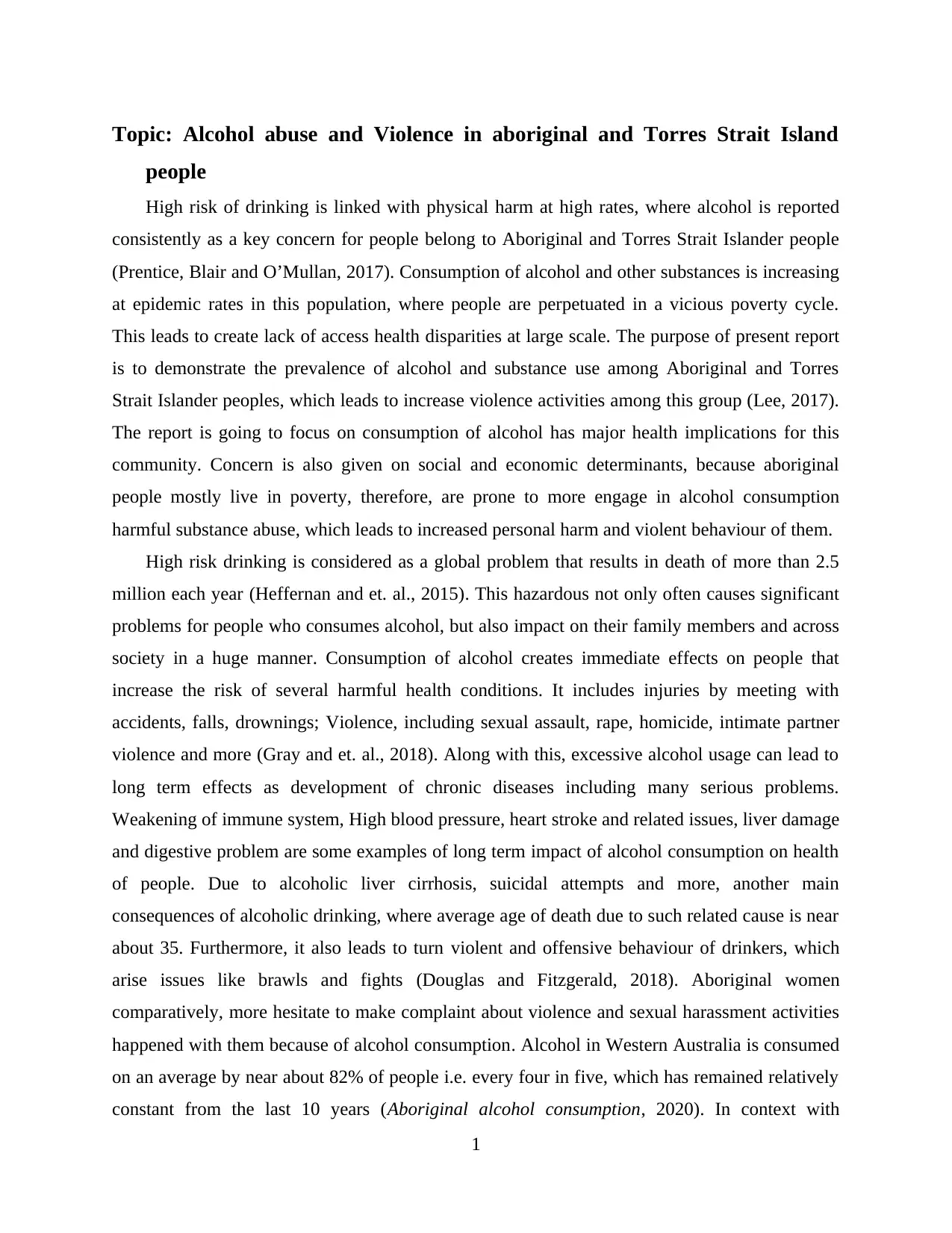
Topic: Alcohol abuse and Violence in aboriginal and Torres Strait Island
people
High risk of drinking is linked with physical harm at high rates, where alcohol is reported
consistently as a key concern for people belong to Aboriginal and Torres Strait Islander people
(Prentice, Blair and O’Mullan, 2017). Consumption of alcohol and other substances is increasing
at epidemic rates in this population, where people are perpetuated in a vicious poverty cycle.
This leads to create lack of access health disparities at large scale. The purpose of present report
is to demonstrate the prevalence of alcohol and substance use among Aboriginal and Torres
Strait Islander peoples, which leads to increase violence activities among this group (Lee, 2017).
The report is going to focus on consumption of alcohol has major health implications for this
community. Concern is also given on social and economic determinants, because aboriginal
people mostly live in poverty, therefore, are prone to more engage in alcohol consumption
harmful substance abuse, which leads to increased personal harm and violent behaviour of them.
High risk drinking is considered as a global problem that results in death of more than 2.5
million each year (Heffernan and et. al., 2015). This hazardous not only often causes significant
problems for people who consumes alcohol, but also impact on their family members and across
society in a huge manner. Consumption of alcohol creates immediate effects on people that
increase the risk of several harmful health conditions. It includes injuries by meeting with
accidents, falls, drownings; Violence, including sexual assault, rape, homicide, intimate partner
violence and more (Gray and et. al., 2018). Along with this, excessive alcohol usage can lead to
long term effects as development of chronic diseases including many serious problems.
Weakening of immune system, High blood pressure, heart stroke and related issues, liver damage
and digestive problem are some examples of long term impact of alcohol consumption on health
of people. Due to alcoholic liver cirrhosis, suicidal attempts and more, another main
consequences of alcoholic drinking, where average age of death due to such related cause is near
about 35. Furthermore, it also leads to turn violent and offensive behaviour of drinkers, which
arise issues like brawls and fights (Douglas and Fitzgerald, 2018). Aboriginal women
comparatively, more hesitate to make complaint about violence and sexual harassment activities
happened with them because of alcohol consumption. Alcohol in Western Australia is consumed
on an average by near about 82% of people i.e. every four in five, which has remained relatively
constant from the last 10 years (Aboriginal alcohol consumption, 2020). In context with
1
people
High risk of drinking is linked with physical harm at high rates, where alcohol is reported
consistently as a key concern for people belong to Aboriginal and Torres Strait Islander people
(Prentice, Blair and O’Mullan, 2017). Consumption of alcohol and other substances is increasing
at epidemic rates in this population, where people are perpetuated in a vicious poverty cycle.
This leads to create lack of access health disparities at large scale. The purpose of present report
is to demonstrate the prevalence of alcohol and substance use among Aboriginal and Torres
Strait Islander peoples, which leads to increase violence activities among this group (Lee, 2017).
The report is going to focus on consumption of alcohol has major health implications for this
community. Concern is also given on social and economic determinants, because aboriginal
people mostly live in poverty, therefore, are prone to more engage in alcohol consumption
harmful substance abuse, which leads to increased personal harm and violent behaviour of them.
High risk drinking is considered as a global problem that results in death of more than 2.5
million each year (Heffernan and et. al., 2015). This hazardous not only often causes significant
problems for people who consumes alcohol, but also impact on their family members and across
society in a huge manner. Consumption of alcohol creates immediate effects on people that
increase the risk of several harmful health conditions. It includes injuries by meeting with
accidents, falls, drownings; Violence, including sexual assault, rape, homicide, intimate partner
violence and more (Gray and et. al., 2018). Along with this, excessive alcohol usage can lead to
long term effects as development of chronic diseases including many serious problems.
Weakening of immune system, High blood pressure, heart stroke and related issues, liver damage
and digestive problem are some examples of long term impact of alcohol consumption on health
of people. Due to alcoholic liver cirrhosis, suicidal attempts and more, another main
consequences of alcoholic drinking, where average age of death due to such related cause is near
about 35. Furthermore, it also leads to turn violent and offensive behaviour of drinkers, which
arise issues like brawls and fights (Douglas and Fitzgerald, 2018). Aboriginal women
comparatively, more hesitate to make complaint about violence and sexual harassment activities
happened with them because of alcohol consumption. Alcohol in Western Australia is consumed
on an average by near about 82% of people i.e. every four in five, which has remained relatively
constant from the last 10 years (Aboriginal alcohol consumption, 2020). In context with
1
⊘ This is a preview!⊘
Do you want full access?
Subscribe today to unlock all pages.

Trusted by 1+ million students worldwide
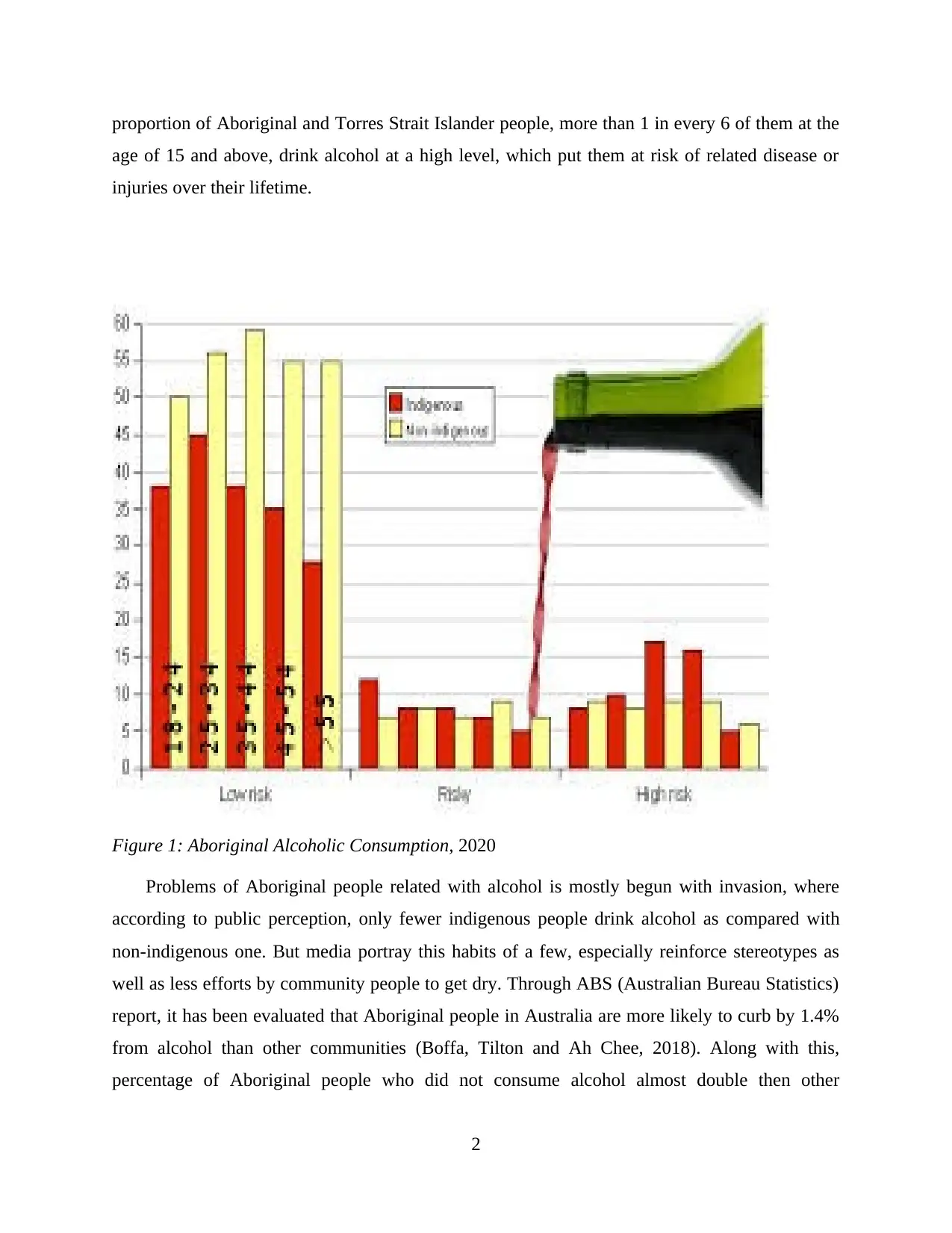
proportion of Aboriginal and Torres Strait Islander people, more than 1 in every 6 of them at the
age of 15 and above, drink alcohol at a high level, which put them at risk of related disease or
injuries over their lifetime.
Figure 1: Aboriginal Alcoholic Consumption, 2020
Problems of Aboriginal people related with alcohol is mostly begun with invasion, where
according to public perception, only fewer indigenous people drink alcohol as compared with
non-indigenous one. But media portray this habits of a few, especially reinforce stereotypes as
well as less efforts by community people to get dry. Through ABS (Australian Bureau Statistics)
report, it has been evaluated that Aboriginal people in Australia are more likely to curb by 1.4%
from alcohol than other communities (Boffa, Tilton and Ah Chee, 2018). Along with this,
percentage of Aboriginal people who did not consume alcohol almost double then other
2
age of 15 and above, drink alcohol at a high level, which put them at risk of related disease or
injuries over their lifetime.
Figure 1: Aboriginal Alcoholic Consumption, 2020
Problems of Aboriginal people related with alcohol is mostly begun with invasion, where
according to public perception, only fewer indigenous people drink alcohol as compared with
non-indigenous one. But media portray this habits of a few, especially reinforce stereotypes as
well as less efforts by community people to get dry. Through ABS (Australian Bureau Statistics)
report, it has been evaluated that Aboriginal people in Australia are more likely to curb by 1.4%
from alcohol than other communities (Boffa, Tilton and Ah Chee, 2018). Along with this,
percentage of Aboriginal people who did not consume alcohol almost double then other
2
Paraphrase This Document
Need a fresh take? Get an instant paraphrase of this document with our AI Paraphraser
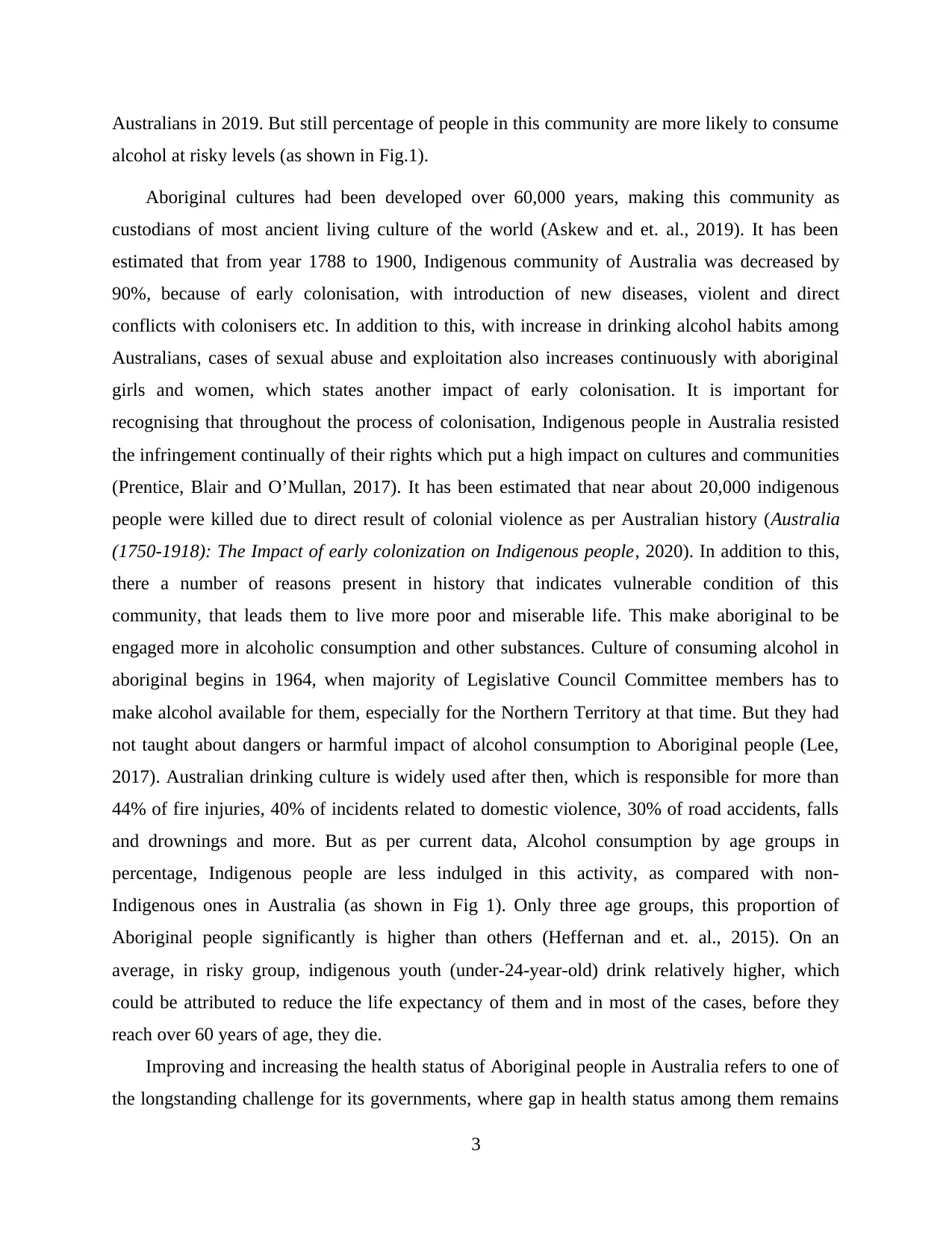
Australians in 2019. But still percentage of people in this community are more likely to consume
alcohol at risky levels (as shown in Fig.1).
Aboriginal cultures had been developed over 60,000 years, making this community as
custodians of most ancient living culture of the world (Askew and et. al., 2019). It has been
estimated that from year 1788 to 1900, Indigenous community of Australia was decreased by
90%, because of early colonisation, with introduction of new diseases, violent and direct
conflicts with colonisers etc. In addition to this, with increase in drinking alcohol habits among
Australians, cases of sexual abuse and exploitation also increases continuously with aboriginal
girls and women, which states another impact of early colonisation. It is important for
recognising that throughout the process of colonisation, Indigenous people in Australia resisted
the infringement continually of their rights which put a high impact on cultures and communities
(Prentice, Blair and O’Mullan, 2017). It has been estimated that near about 20,000 indigenous
people were killed due to direct result of colonial violence as per Australian history (Australia
(1750-1918): The Impact of early colonization on Indigenous people, 2020). In addition to this,
there a number of reasons present in history that indicates vulnerable condition of this
community, that leads them to live more poor and miserable life. This make aboriginal to be
engaged more in alcoholic consumption and other substances. Culture of consuming alcohol in
aboriginal begins in 1964, when majority of Legislative Council Committee members has to
make alcohol available for them, especially for the Northern Territory at that time. But they had
not taught about dangers or harmful impact of alcohol consumption to Aboriginal people (Lee,
2017). Australian drinking culture is widely used after then, which is responsible for more than
44% of fire injuries, 40% of incidents related to domestic violence, 30% of road accidents, falls
and drownings and more. But as per current data, Alcohol consumption by age groups in
percentage, Indigenous people are less indulged in this activity, as compared with non-
Indigenous ones in Australia (as shown in Fig 1). Only three age groups, this proportion of
Aboriginal people significantly is higher than others (Heffernan and et. al., 2015). On an
average, in risky group, indigenous youth (under-24-year-old) drink relatively higher, which
could be attributed to reduce the life expectancy of them and in most of the cases, before they
reach over 60 years of age, they die.
Improving and increasing the health status of Aboriginal people in Australia refers to one of
the longstanding challenge for its governments, where gap in health status among them remains
3
alcohol at risky levels (as shown in Fig.1).
Aboriginal cultures had been developed over 60,000 years, making this community as
custodians of most ancient living culture of the world (Askew and et. al., 2019). It has been
estimated that from year 1788 to 1900, Indigenous community of Australia was decreased by
90%, because of early colonisation, with introduction of new diseases, violent and direct
conflicts with colonisers etc. In addition to this, with increase in drinking alcohol habits among
Australians, cases of sexual abuse and exploitation also increases continuously with aboriginal
girls and women, which states another impact of early colonisation. It is important for
recognising that throughout the process of colonisation, Indigenous people in Australia resisted
the infringement continually of their rights which put a high impact on cultures and communities
(Prentice, Blair and O’Mullan, 2017). It has been estimated that near about 20,000 indigenous
people were killed due to direct result of colonial violence as per Australian history (Australia
(1750-1918): The Impact of early colonization on Indigenous people, 2020). In addition to this,
there a number of reasons present in history that indicates vulnerable condition of this
community, that leads them to live more poor and miserable life. This make aboriginal to be
engaged more in alcoholic consumption and other substances. Culture of consuming alcohol in
aboriginal begins in 1964, when majority of Legislative Council Committee members has to
make alcohol available for them, especially for the Northern Territory at that time. But they had
not taught about dangers or harmful impact of alcohol consumption to Aboriginal people (Lee,
2017). Australian drinking culture is widely used after then, which is responsible for more than
44% of fire injuries, 40% of incidents related to domestic violence, 30% of road accidents, falls
and drownings and more. But as per current data, Alcohol consumption by age groups in
percentage, Indigenous people are less indulged in this activity, as compared with non-
Indigenous ones in Australia (as shown in Fig 1). Only three age groups, this proportion of
Aboriginal people significantly is higher than others (Heffernan and et. al., 2015). On an
average, in risky group, indigenous youth (under-24-year-old) drink relatively higher, which
could be attributed to reduce the life expectancy of them and in most of the cases, before they
reach over 60 years of age, they die.
Improving and increasing the health status of Aboriginal people in Australia refers to one of
the longstanding challenge for its governments, where gap in health status among them remains
3
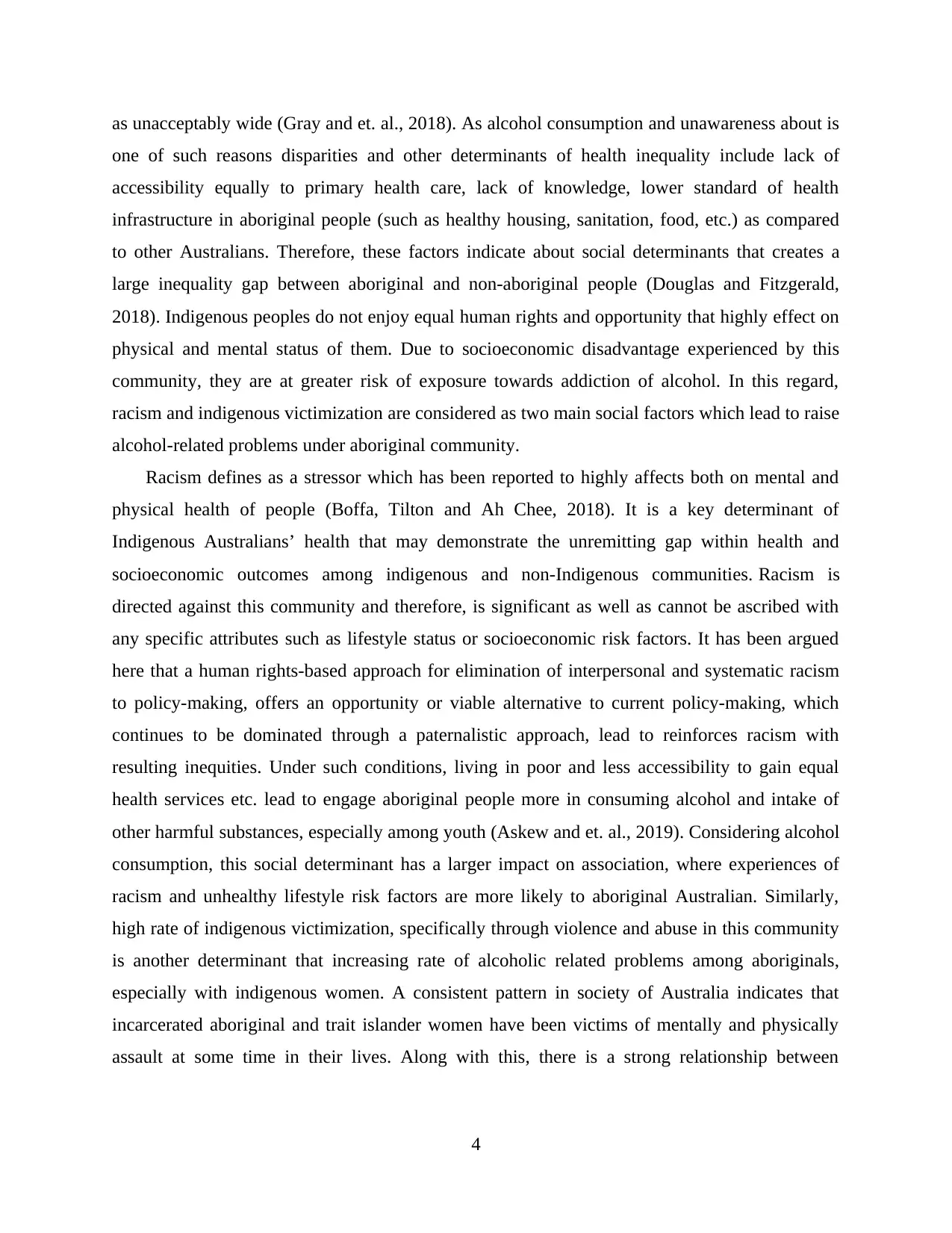
as unacceptably wide (Gray and et. al., 2018). As alcohol consumption and unawareness about is
one of such reasons disparities and other determinants of health inequality include lack of
accessibility equally to primary health care, lack of knowledge, lower standard of health
infrastructure in aboriginal people (such as healthy housing, sanitation, food, etc.) as compared
to other Australians. Therefore, these factors indicate about social determinants that creates a
large inequality gap between aboriginal and non-aboriginal people (Douglas and Fitzgerald,
2018). Indigenous peoples do not enjoy equal human rights and opportunity that highly effect on
physical and mental status of them. Due to socioeconomic disadvantage experienced by this
community, they are at greater risk of exposure towards addiction of alcohol. In this regard,
racism and indigenous victimization are considered as two main social factors which lead to raise
alcohol-related problems under aboriginal community.
Racism defines as a stressor which has been reported to highly affects both on mental and
physical health of people (Boffa, Tilton and Ah Chee, 2018). It is a key determinant of
Indigenous Australians’ health that may demonstrate the unremitting gap within health and
socioeconomic outcomes among indigenous and non-Indigenous communities. Racism is
directed against this community and therefore, is significant as well as cannot be ascribed with
any specific attributes such as lifestyle status or socioeconomic risk factors. It has been argued
here that a human rights-based approach for elimination of interpersonal and systematic racism
to policy-making, offers an opportunity or viable alternative to current policy-making, which
continues to be dominated through a paternalistic approach, lead to reinforces racism with
resulting inequities. Under such conditions, living in poor and less accessibility to gain equal
health services etc. lead to engage aboriginal people more in consuming alcohol and intake of
other harmful substances, especially among youth (Askew and et. al., 2019). Considering alcohol
consumption, this social determinant has a larger impact on association, where experiences of
racism and unhealthy lifestyle risk factors are more likely to aboriginal Australian. Similarly,
high rate of indigenous victimization, specifically through violence and abuse in this community
is another determinant that increasing rate of alcoholic related problems among aboriginals,
especially with indigenous women. A consistent pattern in society of Australia indicates that
incarcerated aboriginal and trait islander women have been victims of mentally and physically
assault at some time in their lives. Along with this, there is a strong relationship between
4
one of such reasons disparities and other determinants of health inequality include lack of
accessibility equally to primary health care, lack of knowledge, lower standard of health
infrastructure in aboriginal people (such as healthy housing, sanitation, food, etc.) as compared
to other Australians. Therefore, these factors indicate about social determinants that creates a
large inequality gap between aboriginal and non-aboriginal people (Douglas and Fitzgerald,
2018). Indigenous peoples do not enjoy equal human rights and opportunity that highly effect on
physical and mental status of them. Due to socioeconomic disadvantage experienced by this
community, they are at greater risk of exposure towards addiction of alcohol. In this regard,
racism and indigenous victimization are considered as two main social factors which lead to raise
alcohol-related problems under aboriginal community.
Racism defines as a stressor which has been reported to highly affects both on mental and
physical health of people (Boffa, Tilton and Ah Chee, 2018). It is a key determinant of
Indigenous Australians’ health that may demonstrate the unremitting gap within health and
socioeconomic outcomes among indigenous and non-Indigenous communities. Racism is
directed against this community and therefore, is significant as well as cannot be ascribed with
any specific attributes such as lifestyle status or socioeconomic risk factors. It has been argued
here that a human rights-based approach for elimination of interpersonal and systematic racism
to policy-making, offers an opportunity or viable alternative to current policy-making, which
continues to be dominated through a paternalistic approach, lead to reinforces racism with
resulting inequities. Under such conditions, living in poor and less accessibility to gain equal
health services etc. lead to engage aboriginal people more in consuming alcohol and intake of
other harmful substances, especially among youth (Askew and et. al., 2019). Considering alcohol
consumption, this social determinant has a larger impact on association, where experiences of
racism and unhealthy lifestyle risk factors are more likely to aboriginal Australian. Similarly,
high rate of indigenous victimization, specifically through violence and abuse in this community
is another determinant that increasing rate of alcoholic related problems among aboriginals,
especially with indigenous women. A consistent pattern in society of Australia indicates that
incarcerated aboriginal and trait islander women have been victims of mentally and physically
assault at some time in their lives. Along with this, there is a strong relationship between
4
⊘ This is a preview!⊘
Do you want full access?
Subscribe today to unlock all pages.

Trusted by 1+ million students worldwide
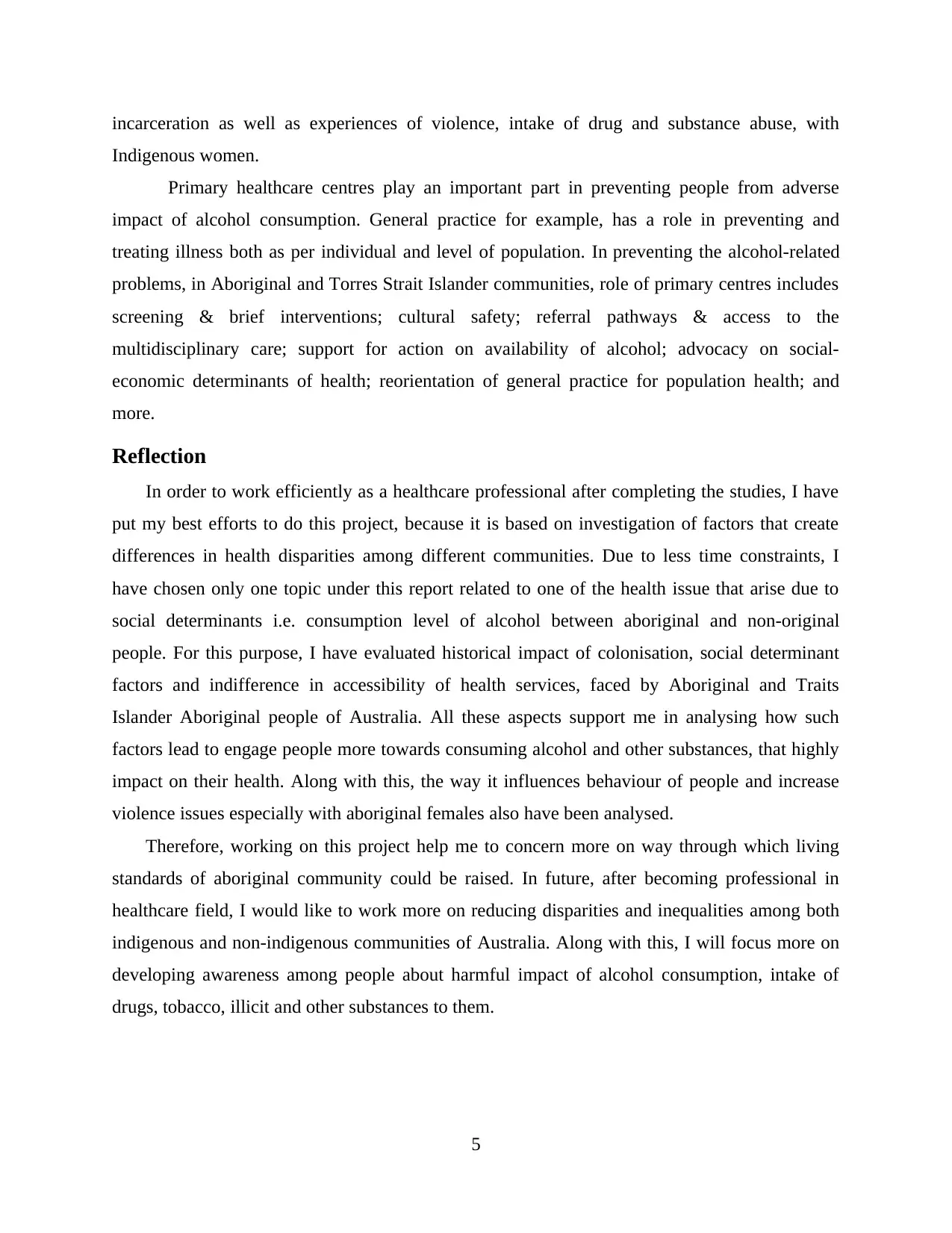
incarceration as well as experiences of violence, intake of drug and substance abuse, with
Indigenous women.
Primary healthcare centres play an important part in preventing people from adverse
impact of alcohol consumption. General practice for example, has a role in preventing and
treating illness both as per individual and level of population. In preventing the alcohol-related
problems, in Aboriginal and Torres Strait Islander communities, role of primary centres includes
screening & brief interventions; cultural safety; referral pathways & access to the
multidisciplinary care; support for action on availability of alcohol; advocacy on social-
economic determinants of health; reorientation of general practice for population health; and
more.
Reflection
In order to work efficiently as a healthcare professional after completing the studies, I have
put my best efforts to do this project, because it is based on investigation of factors that create
differences in health disparities among different communities. Due to less time constraints, I
have chosen only one topic under this report related to one of the health issue that arise due to
social determinants i.e. consumption level of alcohol between aboriginal and non-original
people. For this purpose, I have evaluated historical impact of colonisation, social determinant
factors and indifference in accessibility of health services, faced by Aboriginal and Traits
Islander Aboriginal people of Australia. All these aspects support me in analysing how such
factors lead to engage people more towards consuming alcohol and other substances, that highly
impact on their health. Along with this, the way it influences behaviour of people and increase
violence issues especially with aboriginal females also have been analysed.
Therefore, working on this project help me to concern more on way through which living
standards of aboriginal community could be raised. In future, after becoming professional in
healthcare field, I would like to work more on reducing disparities and inequalities among both
indigenous and non-indigenous communities of Australia. Along with this, I will focus more on
developing awareness among people about harmful impact of alcohol consumption, intake of
drugs, tobacco, illicit and other substances to them.
5
Indigenous women.
Primary healthcare centres play an important part in preventing people from adverse
impact of alcohol consumption. General practice for example, has a role in preventing and
treating illness both as per individual and level of population. In preventing the alcohol-related
problems, in Aboriginal and Torres Strait Islander communities, role of primary centres includes
screening & brief interventions; cultural safety; referral pathways & access to the
multidisciplinary care; support for action on availability of alcohol; advocacy on social-
economic determinants of health; reorientation of general practice for population health; and
more.
Reflection
In order to work efficiently as a healthcare professional after completing the studies, I have
put my best efforts to do this project, because it is based on investigation of factors that create
differences in health disparities among different communities. Due to less time constraints, I
have chosen only one topic under this report related to one of the health issue that arise due to
social determinants i.e. consumption level of alcohol between aboriginal and non-original
people. For this purpose, I have evaluated historical impact of colonisation, social determinant
factors and indifference in accessibility of health services, faced by Aboriginal and Traits
Islander Aboriginal people of Australia. All these aspects support me in analysing how such
factors lead to engage people more towards consuming alcohol and other substances, that highly
impact on their health. Along with this, the way it influences behaviour of people and increase
violence issues especially with aboriginal females also have been analysed.
Therefore, working on this project help me to concern more on way through which living
standards of aboriginal community could be raised. In future, after becoming professional in
healthcare field, I would like to work more on reducing disparities and inequalities among both
indigenous and non-indigenous communities of Australia. Along with this, I will focus more on
developing awareness among people about harmful impact of alcohol consumption, intake of
drugs, tobacco, illicit and other substances to them.
5
Paraphrase This Document
Need a fresh take? Get an instant paraphrase of this document with our AI Paraphraser
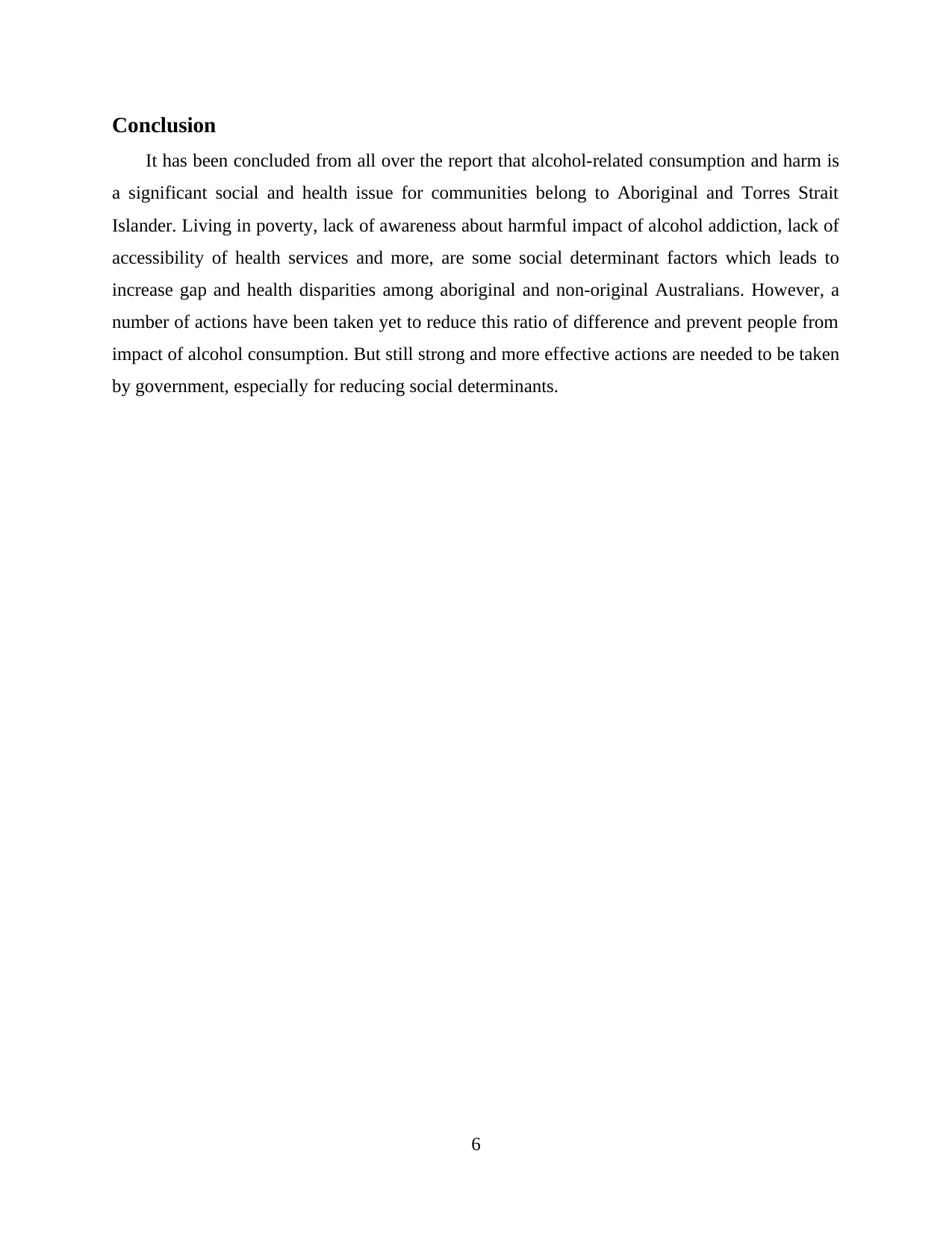
Conclusion
It has been concluded from all over the report that alcohol-related consumption and harm is
a significant social and health issue for communities belong to Aboriginal and Torres Strait
Islander. Living in poverty, lack of awareness about harmful impact of alcohol addiction, lack of
accessibility of health services and more, are some social determinant factors which leads to
increase gap and health disparities among aboriginal and non-original Australians. However, a
number of actions have been taken yet to reduce this ratio of difference and prevent people from
impact of alcohol consumption. But still strong and more effective actions are needed to be taken
by government, especially for reducing social determinants.
6
It has been concluded from all over the report that alcohol-related consumption and harm is
a significant social and health issue for communities belong to Aboriginal and Torres Strait
Islander. Living in poverty, lack of awareness about harmful impact of alcohol addiction, lack of
accessibility of health services and more, are some social determinant factors which leads to
increase gap and health disparities among aboriginal and non-original Australians. However, a
number of actions have been taken yet to reduce this ratio of difference and prevent people from
impact of alcohol consumption. But still strong and more effective actions are needed to be taken
by government, especially for reducing social determinants.
6
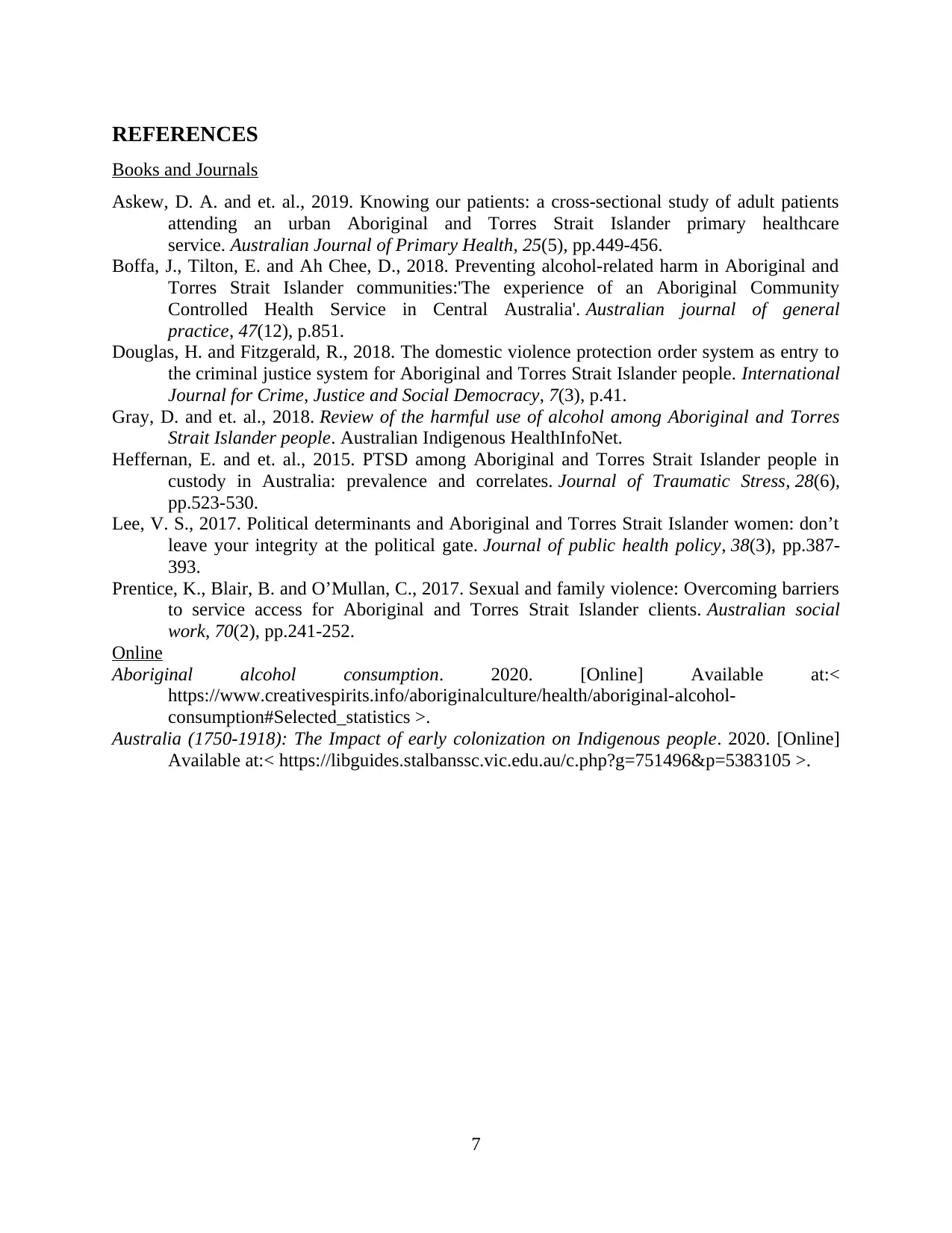
REFERENCES
Books and Journals
Askew, D. A. and et. al., 2019. Knowing our patients: a cross-sectional study of adult patients
attending an urban Aboriginal and Torres Strait Islander primary healthcare
service. Australian Journal of Primary Health, 25(5), pp.449-456.
Boffa, J., Tilton, E. and Ah Chee, D., 2018. Preventing alcohol-related harm in Aboriginal and
Torres Strait Islander communities:'The experience of an Aboriginal Community
Controlled Health Service in Central Australia'. Australian journal of general
practice, 47(12), p.851.
Douglas, H. and Fitzgerald, R., 2018. The domestic violence protection order system as entry to
the criminal justice system for Aboriginal and Torres Strait Islander people. International
Journal for Crime, Justice and Social Democracy, 7(3), p.41.
Gray, D. and et. al., 2018. Review of the harmful use of alcohol among Aboriginal and Torres
Strait Islander people. Australian Indigenous HealthInfoNet.
Heffernan, E. and et. al., 2015. PTSD among Aboriginal and Torres Strait Islander people in
custody in Australia: prevalence and correlates. Journal of Traumatic Stress, 28(6),
pp.523-530.
Lee, V. S., 2017. Political determinants and Aboriginal and Torres Strait Islander women: don’t
leave your integrity at the political gate. Journal of public health policy, 38(3), pp.387-
393.
Prentice, K., Blair, B. and O’Mullan, C., 2017. Sexual and family violence: Overcoming barriers
to service access for Aboriginal and Torres Strait Islander clients. Australian social
work, 70(2), pp.241-252.
Online
Aboriginal alcohol consumption. 2020. [Online] Available at:<
https://www.creativespirits.info/aboriginalculture/health/aboriginal-alcohol-
consumption#Selected_statistics >.
Australia (1750-1918): The Impact of early colonization on Indigenous people. 2020. [Online]
Available at:< https://libguides.stalbanssc.vic.edu.au/c.php?g=751496&p=5383105 >.
7
Books and Journals
Askew, D. A. and et. al., 2019. Knowing our patients: a cross-sectional study of adult patients
attending an urban Aboriginal and Torres Strait Islander primary healthcare
service. Australian Journal of Primary Health, 25(5), pp.449-456.
Boffa, J., Tilton, E. and Ah Chee, D., 2018. Preventing alcohol-related harm in Aboriginal and
Torres Strait Islander communities:'The experience of an Aboriginal Community
Controlled Health Service in Central Australia'. Australian journal of general
practice, 47(12), p.851.
Douglas, H. and Fitzgerald, R., 2018. The domestic violence protection order system as entry to
the criminal justice system for Aboriginal and Torres Strait Islander people. International
Journal for Crime, Justice and Social Democracy, 7(3), p.41.
Gray, D. and et. al., 2018. Review of the harmful use of alcohol among Aboriginal and Torres
Strait Islander people. Australian Indigenous HealthInfoNet.
Heffernan, E. and et. al., 2015. PTSD among Aboriginal and Torres Strait Islander people in
custody in Australia: prevalence and correlates. Journal of Traumatic Stress, 28(6),
pp.523-530.
Lee, V. S., 2017. Political determinants and Aboriginal and Torres Strait Islander women: don’t
leave your integrity at the political gate. Journal of public health policy, 38(3), pp.387-
393.
Prentice, K., Blair, B. and O’Mullan, C., 2017. Sexual and family violence: Overcoming barriers
to service access for Aboriginal and Torres Strait Islander clients. Australian social
work, 70(2), pp.241-252.
Online
Aboriginal alcohol consumption. 2020. [Online] Available at:<
https://www.creativespirits.info/aboriginalculture/health/aboriginal-alcohol-
consumption#Selected_statistics >.
Australia (1750-1918): The Impact of early colonization on Indigenous people. 2020. [Online]
Available at:< https://libguides.stalbanssc.vic.edu.au/c.php?g=751496&p=5383105 >.
7
⊘ This is a preview!⊘
Do you want full access?
Subscribe today to unlock all pages.

Trusted by 1+ million students worldwide
1 out of 9
Related Documents
Your All-in-One AI-Powered Toolkit for Academic Success.
+13062052269
info@desklib.com
Available 24*7 on WhatsApp / Email
![[object Object]](/_next/static/media/star-bottom.7253800d.svg)
Unlock your academic potential
Copyright © 2020–2025 A2Z Services. All Rights Reserved. Developed and managed by ZUCOL.





